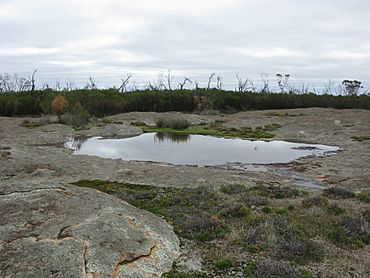Frank Hann National Park facts for kids
Quick facts for kids Frank Hann National ParkWestern Australia |
|
|---|---|
|
IUCN Category II (National Park)
|
|
 |
|
| Nearest town or city | Lake King |
| Established | 1970 |
| Area | 675.5 km2 (260.8 sq mi) |
| Managing authorities | Department of Parks and Wildlife |
| Website | Frank Hann National Park |
| See also | List of protected areas of Western Australia |
Frank Hann National Park is a special natural area in Western Australia. It's about 428 kilometers (266 miles) east of Perth, near the town of Lake King. The park was named after Frank Hann, an early explorer who explored this region. It's a great place to see many different plants, especially beautiful wildflowers that bloom at certain times of the year.
The park was officially created on October 30, 1970. It is managed by the Department of Parks and Wildlife.
Contents
Exploring Frank Hann National Park
This national park is mostly made up of heathland and scrubland. These are areas with small shrubs and bushes, often growing on sandy soil. It's a dry, inland area.
There is no fee to enter the park, which is great for visitors. However, it's important to know that there are no special facilities like toilets or picnic areas inside the park. So, if you visit, you need to be prepared!
Plants of the Park
Frank Hann National Park is home to many unique plants. These plants are adapted to the dry conditions of the region. You can find different types of Acacia plants, which are also known as wattles.
Some of the specific plants found here include:
Animals of the Park
The park is also a habitat for a wide variety of animals, from small lizards and frogs to larger birds and mammals. It's a great place for wildlife spotting!
Reptiles and Amphibians
You might spot different kinds of lizards, such as:
- The marbled gecko
- The clawless gecko
- The crested dragon
- The callose-palmed shining-skink
- The bright crevice skink
Many frog species also live in the park, including:
- Myobatrachus gouldii
- Pseudophryne guentheri
- Limnodynastes dorsalis
Birds of the Park
Birdwatchers will enjoy the park, as many bird species have been seen here. Some of the birds you might find include:
- The emu, Australia's largest bird
- The Australian kestrel, a small falcon
- The brown falcon
- The little eagle
- The crested pigeon
- The brush bronzewing
- The mulga parrot
- The Australian bustard
Mammals of the Park
The park also supports many interesting mammals. These range from small marsupials to larger kangaroos.
- The short-beaked echidna, a spiny mammal
- The western quoll, a carnivorous marsupial
- Gilbert's dunnart, a tiny marsupial
- The honey possum, which feeds on nectar
- The western grey kangaroo, a large marsupial
- The western brush wallaby, a smaller marsupial
- Gould's wattled bat, a type of flying mammal
- Mitchell's hopping mouse, a small rodent that hops


